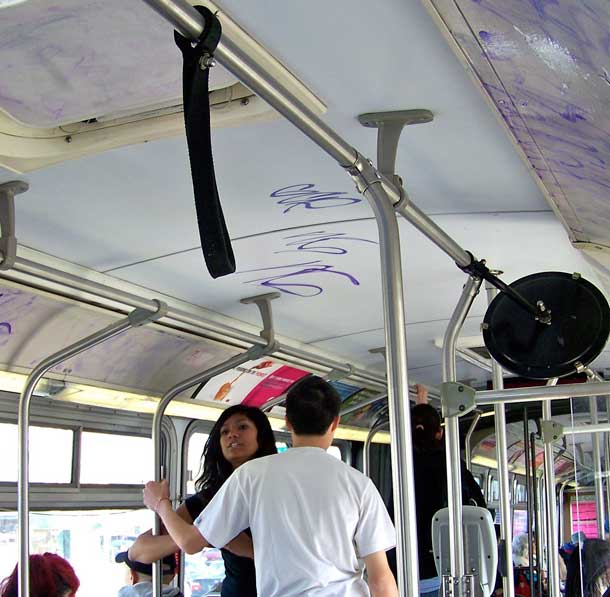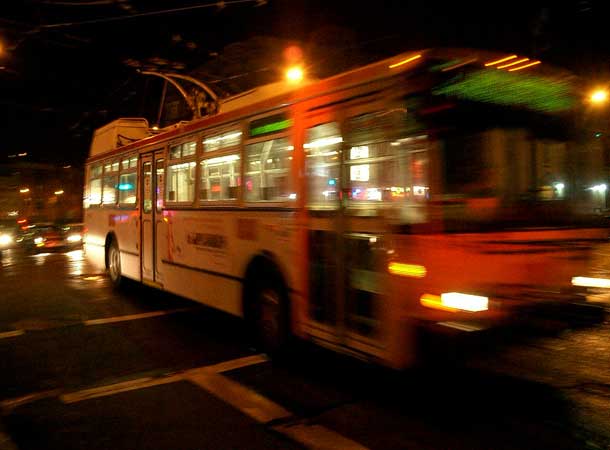This article is part of our EndangerBus project — watch for the buses in San Francisco January 2011!
Imagine a time when cities scrambled to best each other with their transit systems, when few people owned cars, and expanding transit service was the keystone to a local economy. Amid rush-hour gridlock near the Bay Bridge on any weekday, you might think this is eco-fantasy. But this is where transit started out in America, and San Francisco was among the leaders.
Since then the urban ecosystem has changed. Just like other endangered species, transit service has dropped, especially during the second half of the 20th century, out-competed by private automobiles and weakened by diminishing resources.

- Creative Commons photo by Rojer.
Today, though, that urban ecosystem might be changing again, if slowly. A third of San Francisco households don’t own cars, and many residents who do have cars choose to ride transit anyway. They may just be happy to let someone else drive, but the collective result of their individual decisions is that city streets are less noisy, dangerous, and polluted. Where a bus can carry 60 people, cars carry at most 10, and usually just two, in the same road space. And the ride on a bus with fellow citizens is a shared environment, a temporary community reflecting the diversity and vitality of civic life.
That vitality extends beyond that single bus. Each year, San Francisco’s transit system provides over 200 million rides within the city, moving people through a remarkable circulatory system of commuter arteries, weekend service, and nighttime “owl” routes.
Popular routes become the natural focus for people’s homes and businesses. Either by circumstance or (more often recently) by intention, you end up with transit-oriented development, which organizes space for people while leaving generous open areas nearby, both for recreation and wildlife habitat.
In San Francisco, many kinds of vehicles help people get around–buses, streetcars, trolleys, cable cars, taxis, bicycles, BART. More than 800 public transit vehicles cover hundreds of miles of routes, with stops within a short walk for most residents. The most popular routes, such as the 38 Geary, J Church, or 14 Mission, each carry around 30,000 riders in a single day.
Of all the vehicle types, motor buses are the most flexible. They are typically 40 feet long and designed to hold about 60 people, though they often carry more, or fewer. In MUNI’s fleet, 20 percent of their fuel is biodiesel, mostly made from recycled grease here in San Francisco. Muni’s newest buses are electric-biodiesel hybrids, whose bigger windows and low floors make it easier for passengers to get on and off.
Many people depend on the city’s transit systems, and anyone who’s complained about late buses or reduced services knows that these are not easy times for transit.
Slow rides on jammed streets are one major difficulty. Car traffic and double-parking makes travel times longer for riders and operating costs higher for the buses. And that means bus riders face unpredictable travel times, which in turn can lead to drops in ridership.

- Creative Commons photo by Telstar Logistics.
MUNI’s ridership peaked in mid-century, when city residents (about 20 percent fewer people than today) fueled some 320 million rides a year. That dropped by more than half in the 1970s, and has been bouncing between 200 and 250 million ever since.
That’s still a lot of rides, and it takes substantial investment to keep things going at that scale. But transit systems are now starved for funding. MUNI, like many urban public transit agencies, gets only about 20 percent of its operating costs from riders’ fares. The rest comes from federal, state, and local tax dollars, which are harder than ever to come by in a down economy. Unfortunately, funding shortfalls too often lead to fair hikes and service reductions, fueling a vicious cycle of reduced ridership, and then more hikes and reductions. Meanwhile gas prices and bridge financing have favored car travel over transit, making it a tough fight to keep systems running well.
Transit in San Francisco may be endangered but it’s not extinct–and it’s clearly necessary to keep the city healthy and functioning.
Transit agencies and advocates are pushing a host of strategies to help the system run more smoothly and attractively. Prepaid Clipper cards help speed up boarding. Bus rapid transit, where buses have separated, bus-only lanes, is being considered for several major arteries in the city. Charging autos for using roadways in particularly dense downtown areas has been successful in several cities and may be tried soon in San Francisco. And citizens are also organizing themselves, demanding changes in funding priorities and advocating for the services they need.
With some luck, the next decades will see public transportation becoming as pleasant, reliable and ubiquitous as the sidewalk café, taken for granted as a foundation for healthy cities and their surroundings.
To learn more:
TransForm
San Francisco Transit Riders’ Union
San Francisco Municipal Transit Authority (MUNI)
MUNI Diaries
Human Transit

.jpg)

-300x221.jpg)
-300x214.jpg)